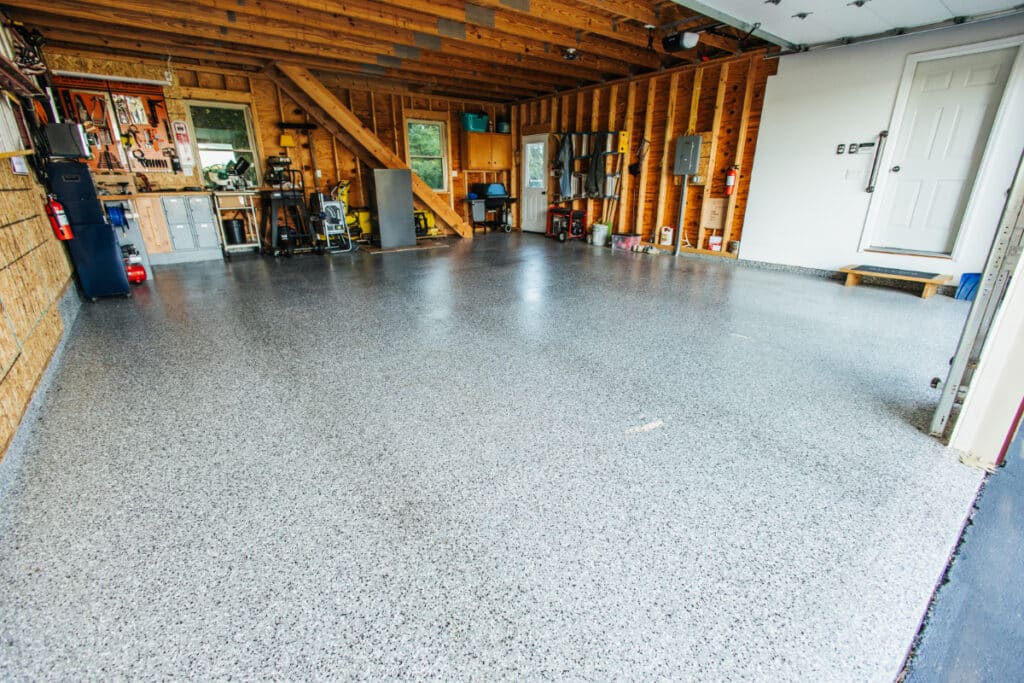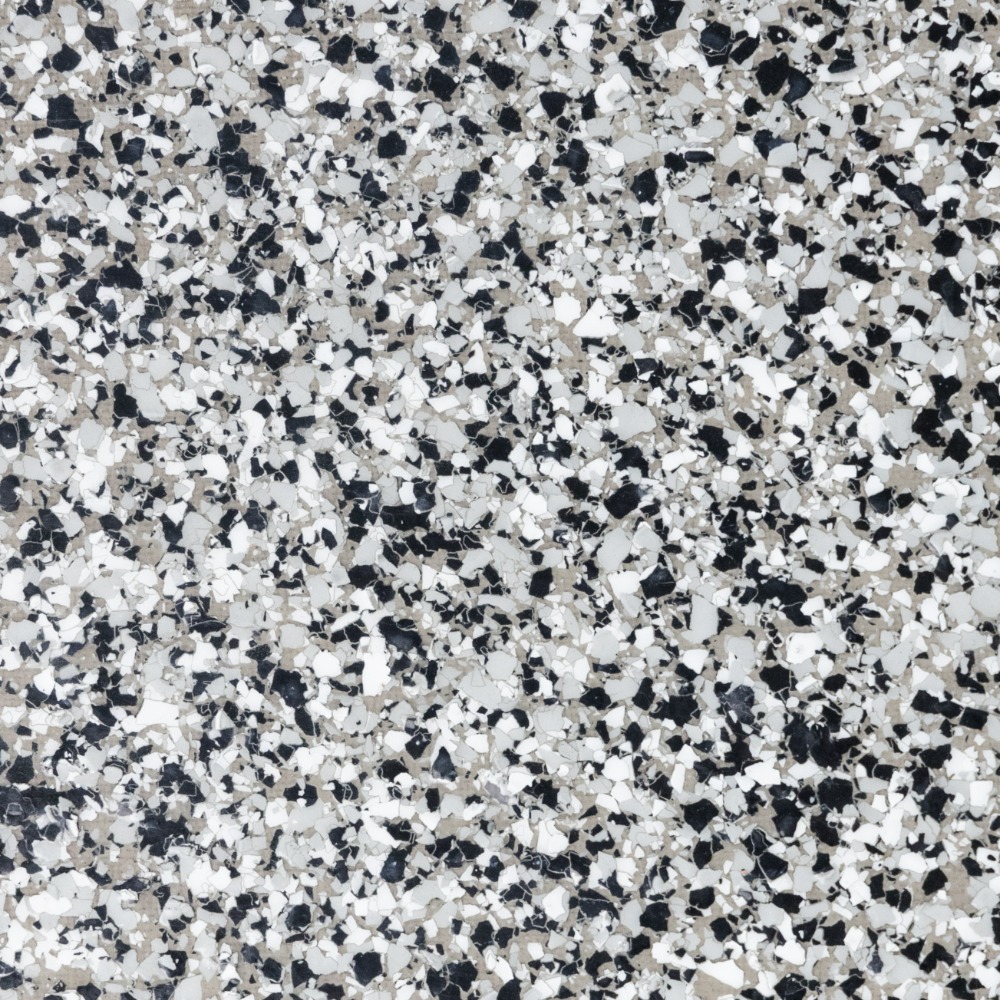Key Takeaways
- Concrete sealers are good enough protection for low-traffic areas like some patios and walkways. They protect against moisture and stains but wear down quickly in high-traffic zones and require frequent reapplication.
- Epoxy and polyaspartic coatings are perfect for high-traffic zones. They bond tightly to the concrete, resist chemicals, scrapes, and wheels, and last for years without needing to reapply more layers. Polyaspartic in particular is now the go-to for lasting concrete surfaces.
- Both sealers and coatings come in different finishes, from matte to glossy, and these coatings can even include color, texture, or slip-resistant additives.
Concrete is amazing. It’s strong, durable, and highly cost-effective. That’s why it’s everywhere from driveways and basements to warehouses and commercial garages.
But that doesn’t mean it’s indestructible. Without a protective barrier, even the toughest concrete floors start looking tired and worn down, especially in spots that get heavy use day in and day out.
You can either seal or coat your concrete. But which one’s better if your floor’s getting stomped, rolled on, and spilled over 24/7?
Why Do Concrete Floors Need Sealing or Coating In The First Place?
Think of an untreated concrete surface like a dry sponge. It may look solid, but it’s actually pretty porous. That means it soaks up moisture, dirt, oil, and whatever else lands on it. Without some kind of protection, your floor will start to look blotchy, stained, and gritty in no time.
That’s where sealers and coatings come into play.
The Lowdown on Concrete Sealers
A concrete floor sealer is like giving your slab a lightweight jacket. It’s not bulletproof, but it definitely helps with daily wear and tear. There are a few different types of sealers out there, and each one comes with its own unique benefits.
- Penetrating sealers: These dig down into the surface and penetrate the pores, repelling moisture, stains, and salt from the inside. They keep the natural look of the concrete, which some people love for patios, exposed aggregate walkways, or simple driveways.
- Acrylic sealers: These sit on top and add a little sheen. Some come in high gloss, others go for a matte vibe. They’re easy to find at home improvement stores, super affordable, and great for both indoor and outdoor applications.
- Water-based sealers: Less odor, easier cleanup, and often suitable for interior jobs.
Applying a concrete sealer is usually quick and painless. You throw down thin coats using a roller or sprayer. Wait for it to be completely dry, then throw on the second coat. Check the label’s instructions, each specific product can be a little picky.
But Are Sealers Enough for Heavy Action?
If we’re talking about a super calm patio or a low-use garage, a sealant can be sufficient. But for industrial, commercial, or simply high-traffic interior and outdoor spaces, sealers don’t cut it.
Over time, vehicle traffic, hot tire pickup, spills, and scrapes wear them down. That once pretty high gloss finish starts looking patchy. And if you don’t keep applying sealer every year or two, you’re back to a stained, old-looking floor.
The Heavy-Duty Champion Is Polyaspartic Epoxy Coatings
If sealers are jackets, coatings are full-on body armor. This protective coating doesn’t just sit on top of your floor, it becomes part of it. It builds a shield so solid that even forklift wheels and chemical spills bounce right off.
The most popular picks?
- Epoxy coatings: While it’s no longer the go-to (that’s polyurea and polyaspartic, below), it adds a thick coat, bonds tight to the concrete, and fights off stains, chemicals, and general abuse. It’s also good-looking, especially if you want that slick showroom finish.
- Polyurethane and polyaspartic options: A little more flexible and UV-resistant, these have replaced traditional epoxy resin. Great for indoor and outdoor applications, especially where you don’t want yellowing or fading from the elements.
And yes, epoxy and polyurea take a bit more effort to apply. Your old concrete might need some grinding or prepping from a professional concrete coating company which makes for full and lasting adhesion. But once it’s down and completely dry, it holds well for years without needing much babysitting.

Who Wins for Busy Spaces?
If we’re talking serious traffic, like warehouses, car showrooms, big commercial kitchens, or a garage floor that sees action every single day, a polyaspartic coating is your best bet. Let’s look at the main reasons why.
- Durability: One good coat lasts several years, even under heavy wheels and clumsy tools.
- Clean-up is a breeze: Spills and dirt just wipe away. No more scrubbing stains out of a bare concrete surface.
- Looks amazing: You can enhance your space with color, texture, and that eye-catching high gloss.
- Slip-resistant options: Some finishes add grit, which helps in wet or slippery spots.
So, What Should You Use?
Here’s the short version:
Low-traffic areas like patios, walkways, or quiet garages? A concrete sealer might work, relying on penetrating or acrylic depending on how you want it to look.
Busy zones with wheels, carts, cars, or family foot traffic? Choose a protective polyaspartic concrete coating . Your floor will thank you.
Looking for help with a new concrete coating in the Finger Lakes? Everlast can help. We’re a concrete coating company in New York serving all of Syracuse, Rochester, Geneva, and more. Call today for a free quote!





